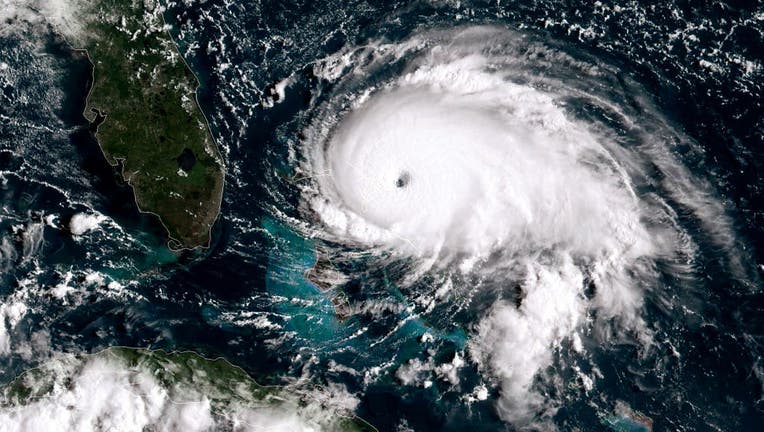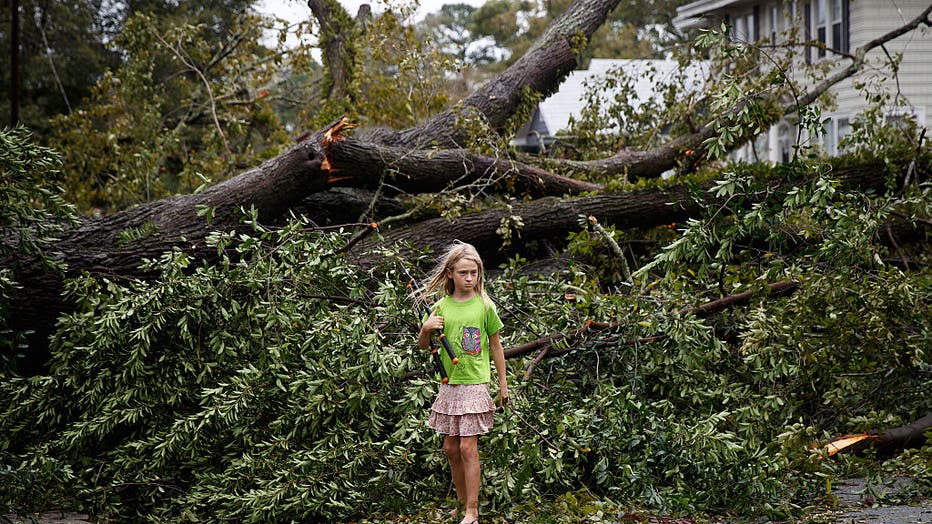Atlantic Hurricane Season 2023: States prepare for possible severe storms

In this NOAA GOES-East satellite handout image, Hurricane Dorian tracks towards the Florida coast taken at 13:20Z September 1, 2019 in the Atlantic Ocean. (Photo by NOAA via Getty Images)
The 2023 Atlantic hurricane season starts Thursday and officials say residents of the southeast United States should make sure their storm plans are in place.
While forecasters a predicting a "near-normal" season, Mike Brennan, the director at the National Hurricane Center, stressed during a news conference this week a there’s really nothing normal when it comes to hurricanes.
"A normal season might sound good in comparison to some of the hurricane seasons in the past few years," he said. "But there’s nothing good about a near-normal hurricane season in terms of activity."

Tracking the Tropics: Disturbance in Gulf
The FOX 5 Storm Team is tracking a disturbance in the Gulf of Mexico which may or may not develop over the next 24 hours. Thursday marks the beginning of the 2023 Atlantic Hurricane Season. How this system will impact Florida and Georgia.
The National Oceanic and Atmospheric Administration predicted in late May a 40% chance of 2023 being a near-normal hurricane season, a 30% chance of an above-average season, which has more storms than usual, and a 30% chance of a below-normal season, which has fewer.
Officials are estimating about 12 to 17 named storms this season with as many as nine of those turning into hurricanes and a possible four major hurricanes in the Atlantic.
President Joe Biden says his bipartisan infrastructure law will help communities confront the disastrous weather. So far, billions of dollars in funding have gone towards thousands of projects like building and repairing roads and bridges.
The FOX 5 Storm Team will be giving a special report "Eye on the Tropics" taking a look at 2023's hurricane forecast and examining how Georgia is preparing for storms that may hit our coast.
The special will premiere Thursday night at 7 p.m. on FOX 5.

Frances Long examines an elm tree that fell in front of her family's home, October 8, 2016 in Savannah, Georgia. (Photo by Drew Angerer/Getty Images)
Hurricane names for 2023 season
Hurricanes are named primarily to eliminate confusion if there are two or more storm systems occurring at the same time.
The United States began using female names for storms in 1953 and began alternating male and female names in 1978.
There is a rotating list of Atlantic hurricane season names every six years. The list can then be repeated, with names being eliminated if they are retired from the rotation, according to the National Hurricane Center’s website.
The 2023 hurricane names are: Arlene, Bret, Cindy, Don, Emily, Franklin, Gert, Harold, Idalia, Jose, Katia, Lee, Margot, Nigel, Ophelia, Philippe, Rina, Sean, Tammy, Vince and Whitney.
Hurricane names are routinely retired if a storm was so deadly or caused so much destruction that using the name again would be inappropriate. It’s not up to the National Hurricane Center to retire a name, however. That practice is left to an international committee of the World Meteorological Organization, which selects another name to replace the retired one.
The most recent names to be retired include Ian, which struck southwest Florida as a Category 5 hurricane in September 2022 with ferocious winds and storm surge as high as 15 feet. Ian killed more than 156 people in the U.S., the vast majority in Florida, according to a comprehensive National Oceanic and Atmospheric Administration report on the hurricane.
Other retired names include Katrina, Harvey, Charley, Wilma, Matthew, Michael and Irma.

Home Depot volunteers prep hurricane kits
FOX 5 Storm Team isn't tracking any tropical storms or hurricanes as this point in the year, but that is not stopping North Georgia volunteers at Home Depot from getting supplies ready for the season ahead.
How could El Nino affect the 2023 season?
El Nino is a natural temporary warming of the Pacific Ocean that occurs every few years, changing weather patterns worldwide.
Generally, the Atlantic is quieter and has fewer storms during El Nino years. That’s because the warmer waters of El Nino make warmer air over the Pacific reach higher into the atmosphere and affect wind shear that could head off storms.
Brennan noted there are other factors that add to the uncertainty of the effects of El Nino, such as very warm sea surface temperatures, weaker low-level easterly flows and a more active African monsoon season.
"So these forces are going to kind of fight it out over the course of this hurricane season," Brennan said. "We don’t know how his season’s going to play out."
What were the worst hurricanes to hit the United States?
In August 1992, powerful Hurricane Andrew struck south of Miami, crossing Florida and making a second landfall in Louisiana. For years, it was the costliest and most damaging hurricane to ever hit the U.S. coastline, resulting in around 65 reported deaths and causing more than $27.3 billion in damages at the time. The Category 5 storm destroyed more than 65,000 houses.
Hurricane Katrina, which struck the New Orleans area as a Category 5 storm in August 2005, still ranks as one of the most devastating hurricanes to hit the United States. Katrina caused more than 1,200 deaths and produced catastrophic damage along the Gulf Coast.
Hurricane Harvey struck Louisiana before slamming into Houston as a Category 4 storm in 2017, causing severe flooding. Harvey killed more than 80 people, including 50 in the Houston area.
According to the National Oceanic and Atmospheric Administration, Katrina and Harvey are listed as the two costliest U.S. hurricanes on record with total costs over $160 billion and $125 billion, respectively.
The Associated Press contributed to this report.

